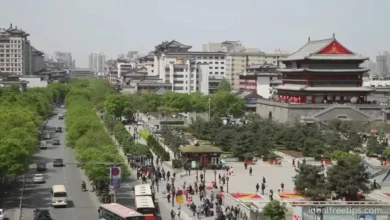
What is Tourist Attraction?
Tourist attractions are places that people love to visit because of their historical, cultural, or natural significance. From breathtaking natural wonders like beaches and mountains to man-made marvels such as museums and entertainment parks, these attractions play a vital role in drawing tourists and contributing to the local economy. In this guide, we’ll explore the importance, purpose, and various types of tourist attractions, including cultural sites, adventure destinations, and events that add excitement to travel experiences.
Define Tourist Attraction?
Tourist attractions are places made to attract visitors, playing a big role in making tourism spots successful. These spots can be natural, like beautiful landscapes, or cultural, like landmarks. They’re created or set up specifically for tourists. Besides helping the local economy grow, they also affect the environment and culture. These attractions can be anywhere, in cities or the countryside, and are important for economic development at different levels. They make a place appealing, help it grow economically, and are studied to understand and rate them better.
What is the Importance of Tourist Attraction in the Tourism Industry?
Tourist spots play a vital role in the tourism industry as they are a key part of the whole tourism setup. They act as the highlights or special features of an area, pulling in tourists and bringing income to the region. These attractions have a big impact on sparking interest in visiting and can make a significant contribution to the success of tourism in a specific place.
The quality of these attractions, including their facilities, ease of access, and extra services, is crucial in drawing visitors and influencing their satisfaction. Additionally, incorporating augmented reality technology into tourism apps can boost the appeal of tourist destinations and offer interactive ways for tourists to explore and learn about the area.
Overall tourist attractions not only contribute to the economic growth of an area but also offer chances for tourists to immerse themselves in new cultures, unwind, and have a good time.
Purpose of Tourist Attraction
The purposes of tourist attractions are to enhance the experience of visitors, support local economies, and aid in the sustainable growth of destinations. As well as to attract travelers and raise a destination’s attraction. These attractions play a number of important roles.
- Cultural and Environmental Preservation
- Economic Growth
- Promotion of Tourism Industry
- Development and Research
- Learning and Fun
- Economic Diversification
- Local development
- Destination Attractiveness
Cultural and Environmental Preservation
A region’s natural and cultural heritage are frequently highlighted and preserved by attractions. Attractions support the preservation of local cultures and natural riches by presenting distinctive landmarks, customs, and landscapes.
Economic Growth
The local economy benefits greatly from the revenue generated by tourism-related activities at tourist destinations. This revenue helps companies operate, generates employment, and supports economic growth in overall.
Promotion of Tourism Industry
Attractions for tourists are essential to the tourism sector’s overall success. They serve as main draws, persuading tourists to pick one location over another.
Development and Research
The study and evaluation of tourist attractions lead to the development of models and systems for classifying and understanding their impact. This research helps in planning and improving the overall tourism experience.
Learning and Fun
Many attractions provide opportunities to learn fascinating things or just have fun. It combines pleasure with knowledge.
Economic Diversification
A region’s economy can be made more diverse by incorporating tourism attractions. Areas may decrease their dependence on particular industries and build a more solid and diverse economic basis by boosting tourism.
Local Development
As growth poles, attractions promote development in the neighborhoods around them. To the advantage of the surrounding area, they promote the development of businesses, services, and infrastructure.
Destination Attractiveness
A destination’s appeal to potential tourists is increased by its tourist attractions. They attract travelers who are eager to see particular locations or engage in particular activities, acting as magnets.
Role of Tourist Attraction
Tourist attractions play a crucial role in the tourism industry. They are placing that people visit for enjoyment and relaxation. Some attractions focus mainly on providing fun, like theme parks and zoos. These places are designed to entertain visitors and make their time enjoyable.
In addition to entertainment, there are attractions that offer educational experiences. Museums and exhibitions fall into this category, providing visitors with opportunities to learn new things while having a good time.
Moreover, tourist attractions can also be spaces for recreation, hospitality, and special events. They create environments where people can unwind, enjoy good food, and participate in unique events.
In essence, these attractions enhance the overall tourism experience by catering to different interests and providing a variety of enjoyable and educational activities.
Types of Tourist Attraction
Around the world, you can find lots of different types of tourist attractions. We can usually group these attractions into four main categories: natural, man-made, sport, and events. Let’s talk about each of these categories.
- Natural Attraction
- Manmade Attraction
- Special Events
- Cultural Attraction
- Adventure Tourism
- Culinary Tourism
- Sites for Religion and Spirituality
- Ecotourism
- Science Tourism and Education Tourism
- Travel for Health and Wellbeing
Natural Attraction
Natural tourist attractions are spots that exist naturally, without humans building them. They are found all around the world, and often, areas nearby these natural attractions are developed for tourism because of their natural beauty.
There are various kinds of natural tourist attractions. Let’s look at some of them:
- National Park
- Beaches
- Caves
- Cliffs
- Mountains
- Hills
- Islands
- Waterfalls
- Forest
Manmade Tourist Attraction
Many types of tourist attraction are purpose built. This means that the attraction is not natural and were created by man. Manmade tourist attraction can be separated in to two groups. Attraction that was made for tourism purposes and attraction that were made for other purposes but has since been used for tourism. Purpose built tourist attraction are attraction that have been purposely developed for tourism. Manmade attraction include:
- Historical or heritage attraction
- Unique built attraction
- Entertainment parks
- Museum and arts galleries
- Wildlife attraction
Special Events
There are many special events. That take place around the world that can be classified as types of tourist attractions. Special events come in all sorts, and there are many different types that can be organized. However, the most usual ones include
- Markets
- Festivals
- Parades
- Exhibitions
- Entertainment venues
Cultural Attraction
This attraction includes theaters, museums, art galleries, and heritage places that highlight the history, art, and cultural legacy of a place.
Adventures Tourism
Attractions that offer thrill-seekers daring experiences like rock climbing, bungee jumping, zip-lining, and other extreme activities.
Culinary Tourism
locations and events that center on food and cooking, include food markets, cooking schools, and well-known restaurants.
Sites for Religion and Spirituality
locations of spiritual or religious value, such as churches, mosques, temples, and pilgrimage sites.
Ecotourism
Encouraging eco-friendly travel to protected regions while putting a focus on preservation, ethical travel, and respect for the environment.
Science Tourism and Education Tourism
Observatories, zoos, science centers, and educational establishments providing interesting and instructive experiences.
Travel for Health and Wellbeing
Natural hot springs, wellness centers, and spas are draws for people looking to unwind and revitalize.
Conclusion
Tourist attractions are the heart of the tourism industry, enticing visitors with their historical, cultural, or natural allure. They not only contribute significantly to local economies but also play a pivotal role in cultural preservation, economic diversification, and destination attractiveness. From natural wonders to man-made marvels, these attractions offer a myriad of experiences, enhancing tourism and creating lasting memories for travelers worldwide. Whether for fun, education, or relaxation, tourist attractions are the key ingredients that make every journey unique and worthwhile.




